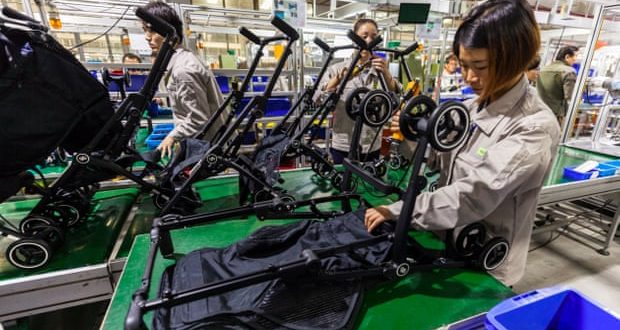Strain begins to show amid a wider slowdown in the world’s second biggest economy
The Chinese economy has revealed fresh signs of the pressure of a trade war with the US and a wider slowdown at home as manufacturing activity fell and the yuan was fixed at a new 10-year low to the dollar.
China’s manufacturing sector barely expanded in October as both domestic and external demand ebbed, according to a closely watched metric released on Wednesday.
The official purchasing managers’ index (PMI) fell to 50.2 in October, the lowest since July 2016 and down from 50.8 in September. A figure below 50 represents a contraction. New export orders, an indicator of future activity, contracted for a fifth straight month and at the fastest pace in at least a year.
The figures suggest a further slowing in the world’s second-biggest economy and could prompt more policy support from Beijing on top of a raft of recent initiatives.
The moves have included pumping tens of billions of dollars into the financial system and other measures to prop up local shares.
Raymond Yeung, chief economist for China at ANZ, said he expected more measures, including cutting the amount of capital banks are required to hold in reserve in order to ease liquidity.
“All the numbers from China’s PMI release today confirm a broad-based decline in economic activity,” said adding that conditions for the private sector was “much worse” than headline data suggested.
“The government’s priority is to avoid a financial blow-up.”
In a further sign of stresses in the economy, the central bank fixed the yuan lower at 6.9646 per US dollar compared with 6.9574 one day earlier. The People’s Bank of China (PBOC) allows the yuan to move 2% either side of the fix and it drifted slightly lower in subsequent trading on Wednesday.
The move will increase tensions with the Trump administration, which has come close to accusing China of currency manipulation after the yuan has fallen in value and made exports more competitive.
The rate is creeping ever closer to the 7 yuan mark – a level regarded as unthinkable three years ago when Beijing succeeded in cementing the yuan’s place as one of the world’s reserve currencies.
A falling yuan will make the country’s exports cheaper and possibly offset the impact of US tariffs, but it will also accelerate capital flight and put downward pressure on asset prices in China such as property.
However, in a sign that China may be ready to see its currency fall further, the China Daily said on Wednesday that allowing the exchange rate to float more freely could be a “wise choice for China, against the backdrop of trade conflicts and economic downside risks.
Capital Economics said this week that it “did not expect the PBOC to hold the line at 7.0 indefinitely”.
October is the first full month after the latest US tariffs went into effect. Washington and Beijing slapped additional tariffs on each other’s goods on 24 September, and Donald Trump has threatened to hit China with more duties.
China’s economy grew at its weakest pace since the global financial crisis in the third quarter, as manufacturing output and infrastructure investment slowed. Analysts believe business conditions will get worse before getting better.
Shares in Shanghai were up 1% on Wednesday in line with markets across Asia Pacific where the Bank of Japan kept rates steady, reinforcing views the central bank is in no rush to trim its massive stimulus.
The Guardian
 Lebanese Ministry of Information
Lebanese Ministry of Information



